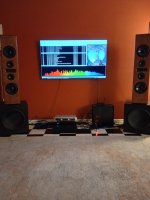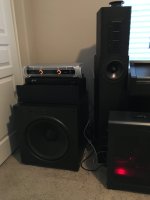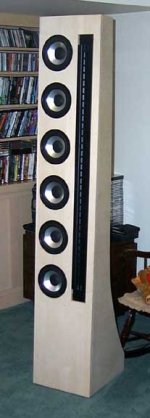To steal from Mark Knopfler:
“then the man he steps right up to the keyboard, and says just as the time bell rings”
How long have you got, ‘cause the professor here can go on - to our enlightenment 😏
“then the man he steps right up to the keyboard, and says just as the time bell rings”
How long have you got, ‘cause the professor here can go on - to our enlightenment 😏
sser2 & planet10 -
I'm feeling convinced the MAOP are the way to go.
What would I be sacrificing or gaining as I go from one extreme to the other in size?
My preference is that the top end remain as effortless as possible but if the larger drivers sacrifice little in that region I'll go with them because I stand a better chance of excluding subs for simplicity and seamlessness without stitching together two bands with a crossover.
I'm feeling convinced the MAOP are the way to go.
What would I be sacrificing or gaining as I go from one extreme to the other in size?
My preference is that the top end remain as effortless as possible but if the larger drivers sacrifice little in that region I'll go with them because I stand a better chance of excluding subs for simplicity and seamlessness without stitching together two bands with a crossover.
The supertest video from virtualhifi did not include any maop drivers.
Of the ones tested, I liked the CHR-70 the most, with the Pluvia a close 2nd. Everything else seems to have lost some clarity and transparency relative to those. The CHN-70 and the other brands might be enjoyed by some if they focus on the mids or tonal balance, but to me they sounded lo-fi.
My favorite experience I had in a commercial setting was when I was auditioning at one of those ultra high end hifi stores back in the day, and they were playing some jazzy sounding stuff, with shimmering brushed cymbals punctuated by bass drum. The recording had a lot of room ambience in it, and I was impressed by the sense of atmosphere and space in that recording which shone through their excellent system. I don't think the drivers other than the chr-70 or pluvia could pull off the highs in the same way.
Perhaps I'm spoiled by my love of planar drivers.
I'm almost ready to make a purchase but I need to listen to this video a few more times and make sure i'm not just being impressed by the treble response but the actual clarity and to give more attention to mids and midbass. I have linear phase / iir / fir eqs that can fix tone problems at the source and when I'm playing 24-192 my eqs are pretty much transparent.
I'll probably buy 3 pairs of different drivers, keep my favorites and sell the other two.
Of the ones tested, I liked the CHR-70 the most, with the Pluvia a close 2nd. Everything else seems to have lost some clarity and transparency relative to those. The CHN-70 and the other brands might be enjoyed by some if they focus on the mids or tonal balance, but to me they sounded lo-fi.
My favorite experience I had in a commercial setting was when I was auditioning at one of those ultra high end hifi stores back in the day, and they were playing some jazzy sounding stuff, with shimmering brushed cymbals punctuated by bass drum. The recording had a lot of room ambience in it, and I was impressed by the sense of atmosphere and space in that recording which shone through their excellent system. I don't think the drivers other than the chr-70 or pluvia could pull off the highs in the same way.
Perhaps I'm spoiled by my love of planar drivers.
I'm almost ready to make a purchase but I need to listen to this video a few more times and make sure i'm not just being impressed by the treble response but the actual clarity and to give more attention to mids and midbass. I have linear phase / iir / fir eqs that can fix tone problems at the source and when I'm playing 24-192 my eqs are pretty much transparent.
I'll probably buy 3 pairs of different drivers, keep my favorites and sell the other two.
Last edited:
For about the last 10 years, my choice for mid and top were Bohlender Graebener planar drivers, specifically Neo-3 (original, not PDR), Neo-8, and Neo-8S. Although I still keep them in high regard, MAOP-7 does everything with the same finesse as Neo-8, but has lows, doesn't suffer from beaming, doesn't need a crossover, and doesn't have driver alignment problem. Stereo imaging of a pair of MAOP-7 is top end.
Although this is speculation, I believe MAOP-10 should not differ much from MAOP-7 in mids and highs, but definitely should be more authoritative in the bass as a single driver.
Although this is speculation, I believe MAOP-10 should not differ much from MAOP-7 in mids and highs, but definitely should be more authoritative in the bass as a single driver.
(mid)bass on the low end and HF articulation on the high end; for instance; 60 - 20 kHz mean:What would I be sacrificing or gaining as I go from one extreme to the other in size?
My preference is that the top end remain as effortless as possible but if the larger drivers sacrifice little in that region I'll go with them because I stand a better chance of excluding subs for simplicity and seamlessness without stitching together two bands with a crossover.
(60*20000)^0.5 = ~1095 Hz = ~34400/pi/1095 = ~10 cm dia./4" disphragm, so 5"? frame and drop to 40 Hz/894 Hz and it's a 6"? frame.
BG Radia were designed to remedy the vertical beaming problem of their Neo drivers. But they were lower sensitivity and created more room reflections. Fix one thing, others suffer.Not mine, but I always wanted to build something with those 48, 60 and 72 inch BG, maybe like this picture.
But by the time I could afford them, they were discontinued.
Yeah, those planar tweeters! On the second picture it looks like Focal midbass. Focal also used the principle of sandwich cone to suppress cone standing waves, fiberglass on front side and paper on back in this case. I have a pair of these, very lightweight cones. Their ultimate sandwich cone is Utopia, used in high end speakers, car audio folks swear by it.sser2
Do you recognize anything here?
As GM said. 😉What particular laws of physics?
Flipping the question, and taking a single example, another way of looking at it is to ask yourself how a compact ducted vent enclosure could provide broadband gain from, say, 40Hz - a mass-corner of 250Hz.
Hmm, somebody finally paying attention to the Babb patent?MAOP-5 is intriguing. No spider, lightest cone, it should be even better than MAOP-7 as mid-hi.
- Home
- Loudspeakers
- Full Range
- Could you point me in the right direction? Markaudio + Enclosure




